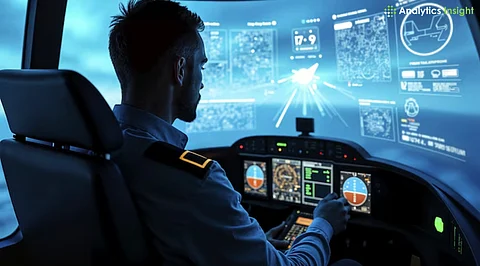

AI-powered systems can detect anomalies, forecast component failures, and provide real-time insights to enhance pilot decision-making.
The global AI in aviation market is projected to reach $22.8 billion by 2032, with a CAGR of 35.38%.
High costs, regulatory compliance, cybersecurity risks, and skilled personnel shortage are key challenges that need to be addressed.
The devastating crash of Air India Flight AI171 in Ahmedabad has left the world mourning and the aviation industry grappling with an urgent question: how do we prevent such tragedies? This disaster demands more than condolences—it calls for bold action to embrace Artificial Intelligence as a cornerstone of aviation safety. With tools like predictive maintenance, real-time monitoring, and anomaly detection, AI holds unparalleled potential to avoid disasters. Let’s take a look at AI’s transformative role in aviation safety, its current applications, market insights, and the pressing need to overcome barriers to its adoption, ensuring that no more lives are lost to preventable accidents.
AI in aviation uses machine learning, computer vision, and big data analytics to enhance safety, efficiency, and decision-making. By analyzing vast datasets from aircraft sensors, weather patterns, and historical flight data, AI systems can predict potential hazards, optimize operations, and reduce human error, which accounts for up to 80% of aviation accidents, with pilot error contributing to 53%. In the context of the Air India crash, where a "Mayday" call was issued before communication was lost, AI-powered systems could have potentially detected anomalies in real-time, providing critical alerts to pilots or air traffic control (ATC).
Predictive Maintenance: AI analyzes sensor data to forecast component failures. For instance, Airbus uses AI to predict maintenance needs, reducing downtime and preventing mechanical failures that could lead to crashes.
Real-Time Monitoring: AI systems process data from engine vibration sensors and "smart skins" to detect anomalies during flight, enabling immediate navigational adjustments.
Air Traffic Management: AI optimizes airspace allocation and runway scheduling, reducing collision risks. Thales and Airbus employ AI for ATC enhancements, improving situational awareness.
Pilot Decision Support: AI-powered cockpit systems provide real-time insights, enhancing pilot decision-making. For example, Microsoft’s Project AirSim trains AI models for autonomous flight scenarios.
Surveillance and Security: AI-enabled drones and cameras, such as Searidge Technologies’ vision AI, monitor airport operations and detect safety concerns in real-time.
The need for safety, efficiency, and cost savings drives the rapid integration of AI in the aviation industry. Let’s take a look at the key market insights with figures:
Market Size and Growth: The global AI in aviation market was valued at US$1,534.91 million in 2023 and is projected to reach US$22,845.24 million by 2032, with a compound annual growth rate (CAGR) of 35.38%.
Regional Dominance: North America holds a 37% market share, driven by investments in AI for baggage screening, passenger identification, and fuel optimization. Europe follows with stringent safety regulations, pushing AI adoption.
Software Segment: AI software, critical for flight planning and predictive maintenance, accounted for 58% of the market share in 2022.
Machine Learning Growth: Machine learning, used for predictive maintenance and route optimization, is the fastest-growing segment, with a projected CAGR of 40.5% from 2024 to 2030.
Investment Trends: Companies like Airbus, Boeing, and Microsoft are heavily investing in AI. For example, Airbus acquired Uptake Technologies in March 2023 to enhance predictive maintenance capabilities.
While the exact cause of the Air India Flight AI171 crash remains under investigation, preliminary reports suggest a possible mechanical failure or external factor, given the "Mayday" call and sudden loss of communication. AI could play a pivotal role in preventing such incidents:
Anomaly Detection: AI systems, such as those used in engine vibration diagnostics, could have identified irregularities in critical components before or during takeoff, potentially alerting the crew to abort or adjust accordingly.
Real-Time Data Integration: AI could have processed real-time data from weather sensors, ATC, and other sources to provide immediate recommendations, potentially mitigating the crash’s outcome.
Pilot Support: AI-driven cockpit assistants could have offered alternative actions during the critical moments following the "Mayday" call, reducing reliance on human response under pressure.
However, the effectiveness of AI depends on its integration and certification. The European Union Aviation Safety Agency (EASA) emphasizes deterministic AI under guidelines like DO-178C to ensure reliability in safety-critical systems. The Air India crash highlights the need to overcome challenges such as high implementation costs and regulatory hurdles to deploy AI solutions fully.
High Costs: Developing and integrating AI systems is expensive, with initial investments posing a barrier for smaller airlines.
Regulatory Compliance: Certifying AI for safety-critical applications, as outlined by EASA’s AI Roadmap 2.0, requires rigorous testing to ensure consistency and reliability.
Cybersecurity Risks: AI systems are vulnerable to cyberattacks, necessitating robust protections to safeguard data and operations.
Skilled Personnel Shortage: The lack of trained professionals to develop and maintain AI systems limits widespread adoption.
The Air India crash serves as a somber reminder of the need for accelerated AI adoption in aviation safety. Future opportunities include:
Autonomous Systems: AI-driven autonomous flight systems, like those being developed by Honeywell and NXP Semiconductors, could reduce human error.
Global Collaboration: International partnerships, as advocated by EASA, can standardize AI safety protocols, ensuring consistent implementation and adherence to these protocols.
Enhanced Training: AI-powered flight simulators and pilot training programs, such as Microsoft’s Project AirSim, can improve pilot preparedness for emergencies.
Sustainability: AI’s role in fuel optimization aligns with green initiatives, reducing environmental impact while enhancing safety and efficiency.
The tragic crash of Air India Flight AI171 once again highlights the critical need for advanced safety measures in aviation. AI offers transformative potential through predictive maintenance, real-time monitoring, and enhanced decision-making, addressing factors that may contribute to such disasters. With the AI in aviation market projected to grow exponentially, investments in technology and regulatory frameworks must accelerate to minimize tragedies like this. By learning from this incident and utilizing the capabilities of AI, the aviation industry can move toward a safer and more resilient future.
Read Also: 10 ways Big Data is Transforming the Aviation Industry
